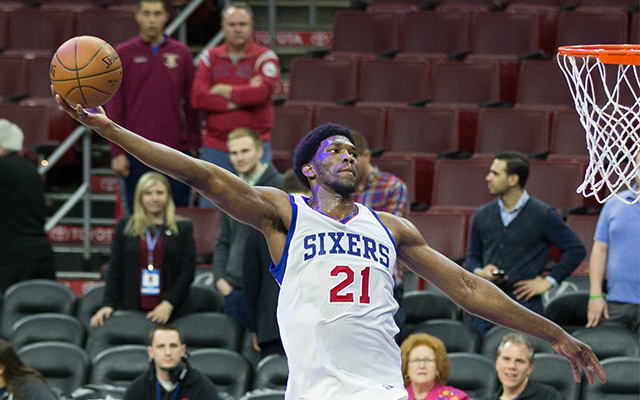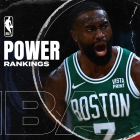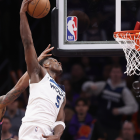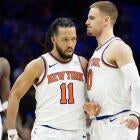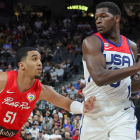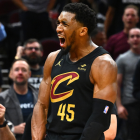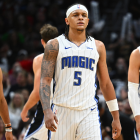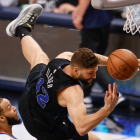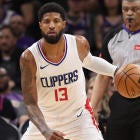The news that Philadelphia 76ers center Joel Embiid will miss his second consecutive NBA season does nothing to simplify the complex situation the team finds itself in. In fact, it only exacerbates the enigmatic status of the franchise.
The Sixers took Embiid with the third overall selection last year. In what's becoming an incredibly polarizing debate, the pick can be viewed as a no-brainer that goes along with the long-term goals of the franchise. On the flip side, the selection can be perceived as a symptomatic decision of the Sixers' greater inability to put team building first. There's room for in-between assessments, but by and large, that's where most fall on the issue.
Embiid represented the layers with the best chance of being a "superstar" at that third spot in 2014. He had been thought of as the consensus No. 1 pick before having medical red flags appear in the month leading up to the draft. It wasn't just that he had injury concerns; it was that he had suffered the very injuries that create the most fear for big men: stress fractures in his back and foot. This contrast between his upside (Hakeem Olajuwon) and his injury-laden floor (Greg Oden) created a vast imbalance in any assessment of the pick.
It's important to note a few things before we continue. First, Embiid's career is not over. Yes, he suffered setback after setback this year, ultimately leading to the second surgery, which was announced Saturday. However, just because players with these kind of debilitating injuries from the get-go have a notorious history doesn't mean that Embiid can't return and be a productive player once his NBA career starts. Second, it's important not to forget the physical and emotional cost of the injury on the player. Embiid's a young man dealing with a second surgery, media scrutiny and the emotional toll of being unable to play the game he's worked so hard to play professionally.
Third, the entire Sixers approach to tanking and asset management can't be boiled down to just the Embiid pick. In many ways, the Dario Saric selection at No. 12 (after trading down from No. 10) in 2014 is just as complicated when paired with the Embiid selection, and vice versa. Lastly, it's unlikely you're going to change your mind on what you thought of the pick at this point. The result isn't going to change how you felt about the process. Those that felt Embiid was too high of an injury risk for how desperately the Sixers needed talent to begin building a team will only consider that viewpoint validated by the unfortunate injury. Those who felt he was worth the risk will double down on trusting the process.
Instead of looking further at the pick and the ramifications of Embiid's injury, when most informed people already have an opinion they're unlikely to stray from, a more interesting question is this: Given the events of the past three weeks, where exactly are the Philadelphia 76ers going?
They're not going to be good this season, let's start there. They're still missing NBA players entirely at key positions. They somehow managed to get worse as the season went on last year, trading K.J. McDaniels (which most of the fanbase didn't like) and former Rookie of the Year Michael Carter-Williams. That last one is hard to argue against entirely, even if you felt, like I did, that the Sixers needlessly moved an asset before they had to. Their return (the Lakers' top-six pick in 2015, 1-3 protected in 2016) made it too good to pass up.
Typically when an NBA team's No. 3 overall pick is slated to miss the entire season, it's a devastating blow to the team's rebuilding efforts. Instead, the Sixers somehow find themselves in roughly the same spot they were in where they drafted Embiid -- no worse, no better. The team was bad enough last year to earn the No. 3 pick again, and this time (again) a top big man prospect once thought to be the No. 1 overall pick fell to them. Jahlil Okafor doesn't have Embiid's upside (at least according to most projections), but he does project as a top-flight post scorer.
Okafor's strengths (post scoring, raw size, touch around the rim) mesh perfectly with Nerlens Noel's weaknesses, and conversely Noel's strengths (rim protection, rebounding, pick-and-roll defense) cover for Okafor's weaknesses. The two fit together like puzzle pieces. Okafor's Summer League performance (for whatever that's worth) has been up and down. He struggled mightily in Utah, with a low release point prone causing struggles, but showed up in Vegas and had a strong game on Saturday.
So does the Okafor pick mean that there's no harm from the Embiid miss? Well, as usual with the Sixers, yes and no. Okafor does mean that they haven't lost ground; they're still a talented team with a great big man combination. However, say the team had taken Aaron Gordon, who had a lower ceiling than Embiid but very much has looked like an impact NBA player during his rookie season (despite an injury issue that caused him to miss some of the season and the need for a reworked jumper he's displayed already in Summer League this month.) Or say they had taken Julius Randle, who may not have suffered the freakish leg fracture he suffered last fall with the Lakers. Or Dante Exum, on down the line.
Would any of those players really make a significant difference in the 76ers' win total, jeopardizing their No. 3 selection? It's unlikely, when you look at how their teams performed. They wouldn't have had the star, but they would've had real NBA talent to help put around Okafor and Noel. Okafor prevented them from losing ground, but Embiid prevented them from having building blocks.
Another way to think of it: If the Sixers intended the Embiid pick to be a swing for the fences with a high chance of a strikeout, drafting Gordon, Exum or Randle (or Payton with the No. 10 instead of Saric at No. 12) would have gotten them a man on base for when they went for the home run this season. Had Embiid been the home run they were looking for, it would have been worth it. That injury risk is part of the equation when we look at the value of the swing. That's what makes the entire ordeal such a maddening rabbit hole of hypotheticals and paradigm justification.
The Sixers will be better in 2016 than they were in 2015. If GM Sam Hinkie's shown one thing, though, it's that if it doesn't look like Noel, Saric, Embiid or Okafor will be a franchise cornerstone, he'll look to trade them. Meanwhile, a good coach and a pretty entertaining team will remain stuck in neutral, the process will remain the same, assets will be gathered and the debate will rage on.
Where are the Sixers going? They're either going nowhere at the speed of light, or moving toward being a championship team at the speed of evolution. At this rate, it may take generations for the Sixers to be contenders either way.
